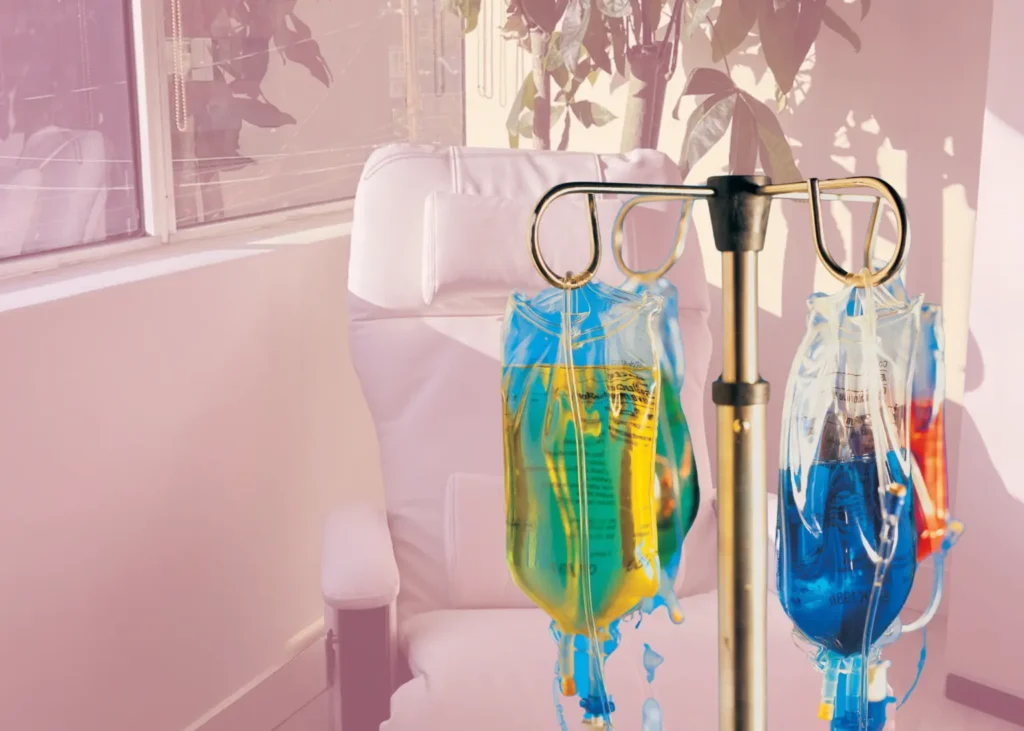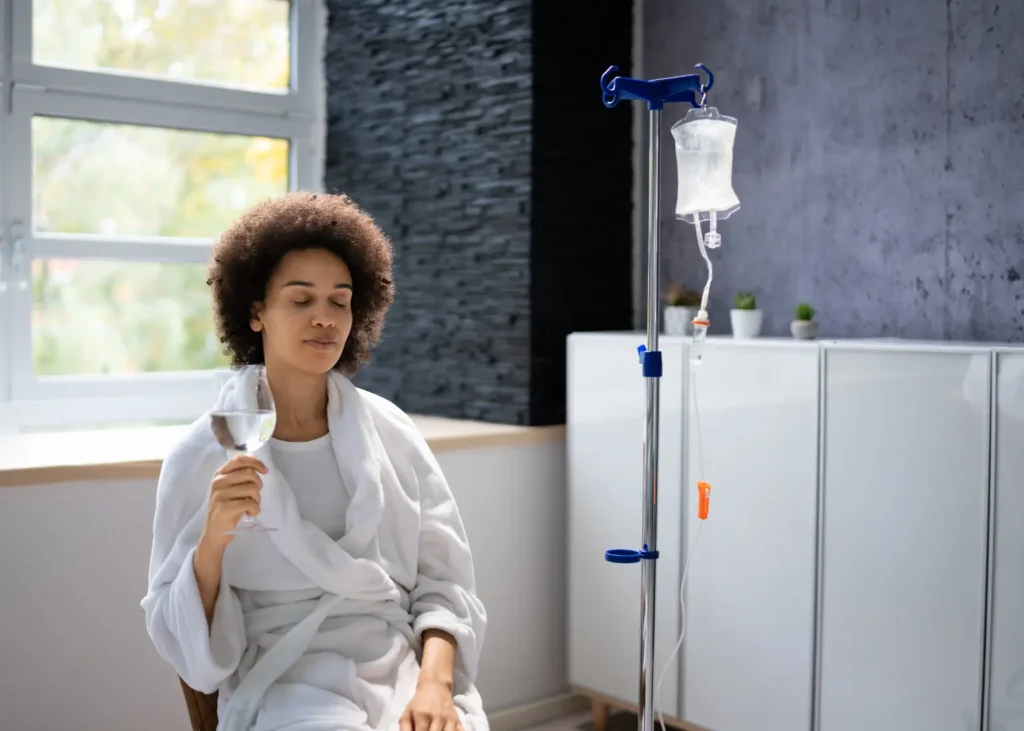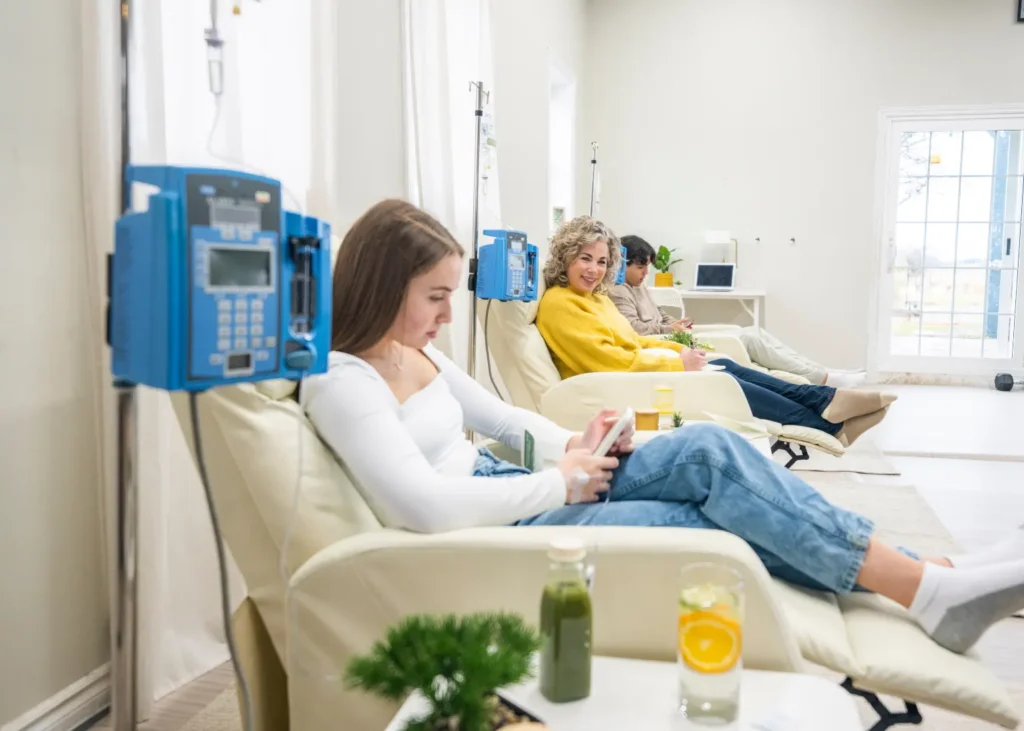Understanding Treatment-Resistant Depression (TRD)
Treatment-resistant depression (TRD) refers to cases of major depression that do not respond to standard antidepressant treatments. Psychiatrists typically diagnose TRD when a patient has tried at least two different antidepressants (at adequate doses and durations) with no significant improvement. This is a common challenge – around 30% of people with major depressive disorder end up meeting the criteria for TRD. These individuals continue to suffer debilitating symptoms despite conventional treatment, highlighting the need for innovative resistant depression solutions beyond the usual medications and talk therapy. Historically, options like electroconvulsive therapy (ECT) or transcranial magnetic stimulation have been used as next steps for difficult cases. However, in recent years, attention has turned toward new approaches such as infusion treatment for depression using novel agents like ketamine.

Ketamine Infusion Therapy: A New Approach to Depression
Ketamine infusion therapy involves delivering ketamine – traditionally an anesthetic medication – directly into the bloodstream via an intravenous (IV) drip. In a typical session, the patient is seated comfortably as a low dose of ketamine is infused over about 40 minutes, with medical staff monitoring vital signs. As an IV therapy for depression, this approach is very different from taking a pill daily; instead, it is a procedural treatment administered in a clinic.
Originally developed in the 1960s as a surgical anesthetic, ketamine is classified as a dissociative anesthetic (it produces dream-like, out-of-body sensations). It has even been used recreationally as a club drug (“special K”) at high doses. However, in recent years, ketamine has gained recognition for its potent antidepressant effects. Researchers discovered that low, sub-anesthetic doses of ketamine can rapidly improve mood in severely depressed patients, even when conventional antidepressants have failed. In fact, ketamine’s use has gone from a fringe idea to widespread use for hard-to-treat depression. Many doctors now view ketamine infusion therapy as a promising treatment for resistant depression, offering hope where other treatments haven’t worked.
A key distinction is that ketamine for depression is currently an off-label treatment. The FDA has not yet formally approved intravenous ketamine for depression (meaning it’s not marketed by a pharmaceutical company for this purpose). The one exception is a closely related drug, esketamine (brand name Spravato), which the FDA approved in 2019 as a nasal spray for adults with TRD. Even that drug must be given in a certified clinic under supervision due to safety monitoring requirements. Still, the success of esketamine and accumulating evidence from IV ketamine studies have fueled rapid growth in ketamine clinics worldwide.
Ketamine’s antidepressant effects stem from its action on the brain’s glutamatergic system, specifically by blocking NMDA receptors—key sites for the neurotransmitter glutamate. This blockade triggers a surge in glutamate release, which rapidly stimulates the growth of new synaptic connections between neurons, enhancing neuroplasticity. Unlike traditional antidepressants that slowly modulate serotonin or norepinephrine, ketamine’s mechanism enables much faster mood improvements, often within hours. By promoting the formation of new neural pathways, ketamine helps “reset” dysfunctional brain circuits associated with depression, offering relief even in cases where other treatments have failed.
How Ketamine Works: A Rapid “Reset” of the Brain
Conventional antidepressants (like SSRIs) work by slowly adjusting neurotransmitters such as serotonin, often taking many weeks to yield an effect. Ketamine works on an entirely different brain system, which helps explain why its effects kick in so much faster. Specifically, ketamine blocks N-methyl-D-aspartate (NMDA) receptors – a type of receptor for the neurotransmitter glutamate – in certain brain cells. This action triggers a surge of glutamate release in the brain, which in turn stimulates the growth of new synaptic connections between neurons (essentially increasing neuroplasticity). By “rewiring” neural circuits in this way, ketamine can lift depression even when other drugs have failed. Crucially, these brain changes happen quickly: patients often experience significant mood improvement within hours of a ketamine infusion, rather than the weeks traditional medications require.
Researchers sometimes describe ketamine’s effect as a “reset” for a depressed brain. For example, people suffering intense suicidal thoughts have often found those thoughts dramatically reduced a day or two after an infusion. The rapid relief can be life-saving in such cases. However, the antidepressant effect of a single ketamine session usually lasts only days to a couple of weeks before symptoms potentially return. For a sustained remission, patients typically undergo a short series of infusions (for instance, six sessions over two to three weeks is a common protocol) and may receive periodic booster infusions thereafter.
It’s worth noting that ketamine’s mind-altering properties – it can cause perceptual distortions or a dreamy, detached state during the session – mean that it’s sometimes classified under psychedelic depression treatment approaches. While ketamine is not a classic hallucinogen like LSD or psilocybin, it similarly induces an altered state of consciousness that some believe contributes to its therapeutic effects (for example, by “opening” the mind to new perspectives during therapy). This has placed ketamine at the forefront of a broader movement exploring psychedelic-assisted therapies for mental health.
The Ketamine Infusion Experience: What to Expect
Undergoing ketamine infusion therapy typically involves a structured process in a medical setting. Patients don’t simply walk in for a shot in the dark; careful screening and support are essential. Below are the common steps in a supervised ketamine treatment program:
- Initial Consultation: The journey usually begins with an evaluation by a physician or psychiatrist. The provider reviews the patient’s history and symptoms to ensure ketamine is an appropriate option. They will also explain the procedure and answer questions.
- Preparation Session: Before the first infusion, many clinics offer a preparatory session. A therapist or clinician helps the patient set intentions and calm any anxiety. They might provide guidance on what to expect, because the ketamine experience can be strange if you’ve never had it. Relaxation techniques and creating a comfortable mindset are often part of preparation.
- Infusion Session: During a ketamine infusion session, the patient is seated or reclining comfortably in a chair. A small IV line is placed, and ketamine is administered slowly over 40 minutes or so. Vital signs (blood pressure, heart rate, oxygen) are monitored continuously. Patients often wear an eye mask and listen to soothing music to help them focus inward. Ketamine’s effects typically begin within minutes: people often describe a floating or dream-like sensation as their consciousness detaches from ordinary reality. A trained staff member is present throughout to ensure safety and provide reassurance.
- Integration & Reflection: After the drug’s acute effects fade (within about 15–30 minutes post-infusion), the patient discusses the experience with a clinician or therapist. This integration phase is crucial – the patient can process any emotions or insights that arose during the session and start linking them to their real-life challenges. Incorporating these insights helps the mood improvements stick. Many clinics emphasize that therapy surrounding the drug is key; the ketamine opens a “window” of neuroplasticity, and guided reflection helps translate that into lasting positive change.
- Follow-Up Care: A course of ketamine therapy usually involves multiple infusions over several weeks, so follow-up is ongoing. The care team will track the patient’s depression symptoms and overall progress. Depending on the response, they may recommend booster infusions in the future or transition the patient back to other treatments once stable. Some providers also combine ketamine with other wellness strategies (therapy, lifestyle changes, support groups) to solidify the gains made.
Every clinic does things a little differently, but in general, the process is designed to be safe and supportive. Patients remain under supervision until any acute side effects (like dissociation or dizziness) wear off, and they are not allowed to drive themselves home afterward. Overall, the setting is more akin to a minor medical procedure or a therapy session than a typical medication pick-up – a reflection of the unique nature of this treatment.
A patient is undergoing ketamine infusion therapy in a comfortable clinical setting under professional supervision. Such infusion therapy for depression is delivered via an IV drip, with careful monitoring throughout the session.
Effectiveness: How Well Does Ketamine Therapy Work?
Clinical research and patient reports both indicate that ketamine can have striking antidepressant effects in many cases of TRD. Unlike standard antidepressants that might only help a subset of patients after months of use, ketamine often yields noticeable improvement after one or two sessions. In one recent clinical trial of ketamine infusion for TRD, patients with long-standing, severe depression received three IV infusions for 11 days. By the end of that short treatment series, about 52% of participants experienced a full remission of their depression, an additional 15% had a meaningful improvement in symptoms, and about half of those who had been struggling with frequent suicidal thoughts prior to treatment no longer experienced such thoughts after the ketamine infusions. These are remarkable outcomes given that all participants had depression that had resisted multiple prior treatments.
That said, ketamine is not a panacea – it doesn’t work for everyone. In the study above, roughly one-third of patients did not respond to ketamine at all. Identifying predictors of response is an active area of research; scientists are examining factors like inflammation markers and genetic profiles to see why some people benefit dramatically while others don’t. There’s also the question of how long the benefits last. Many patients relapse once they stop ketamine, though some maintain improvements for weeks or months. Ongoing or maintenance therapy (such as periodic booster infusions or accompanying psychotherapy) is often recommended to prolong the positive effects. Despite these caveats, the evidence so far positions ketamine as one of the most effective new options for treatment-resistant mood disorders. For individuals who have tried everything else with little success, ketamine provides a much-needed alternative path to relief.

Safety and Side Effects
Any potent treatment comes with potential side effects, and ketamine is no exception. The good news is that low-dose ketamine infusions are generally well-tolerated when given in a controlled setting. The most common acute side effect is the dissociative experience – essentially, feeling “out of body” or disconnected from reality for a short time. This state is expected as part of the ketamine experience and is closely monitored by clinicians. Other typical side effects during or after an infusion include elevated blood pressure, sedation (drowsiness), dizziness, blurred vision, anxiety, nausea, and sometimes vomiting or headache. These effects usually wear off within an hour or so after the infusion ends. Medical staff will usually have the patient stay for observation until they are deemed stable, and patients are advised not to drive until the next day.
Ketamine’s safety profile in medically supervised settings has been encouraging – it does not cause respiratory depression at antidepressant doses (unlike opioids or sedatives), and there have been no long-term organ damage signals in patients receiving intermittent doses for depression. However, certain precautions are taken. People with uncontrolled high blood pressure or serious heart disease may not be good candidates, since ketamine can raise blood pressure transiently. Those with a history of psychosis (such as schizophrenia) are usually excluded because the drug’s mind-altering aspects could potentially exacerbate psychotic symptoms. Providers also screen for any history of substance abuse; while ketamine is used therapeutically at low doses, it is an addictive substance at higher doses and has been misused recreationally. The goal in therapy is to give just enough to induce an antidepressant effect, under careful oversight, with no take-home drug supply. When used in this responsible way, experts consider ketamine reasonably safe for most adults, including those with suicidal depression who might not be able to wait weeks for other treatments to work.
Accessibility and Cost Considerations
While ketamine infusion offers new hope for depression, practical access to this therapy can be limited by geography and cost. Dedicated ketamine infusion therapy clinics have been opening up across the country, but they tend to be concentrated in urban and suburban areas. Most operate on a fee-for-service model, since ketamine infusions for depression are not reliably covered by health insurance. In fact, the cost of ketamine infusion therapy is significant: a single infusion typically costs a few hundred dollars, and a full initial treatment course often involves six infusions over a few weeks. That means the cost of ketamine for depression can quickly add up to several thousand dollars, often to be paid entirely out of pocket. For many individuals, this expense is a major barrier to getting treatment.
The insurance landscape is slowly evolving – some insurers will cover ketamine treatment on a case-by-case basis or for certain providers, but coverage is inconsistent. (Esketamine nasal spray, being FDA-approved, is more often covered by insurance, but it too requires patients to meet strict criteria and to administer it under supervision.) One underlying issue is that generic ketamine was never developed through the formal (and expensive) FDA approval process specifically for depression, so insurance companies generally categorize IV ketamine as an experimental or off-label service. Advocates are pushing for change; researchers and clinicians from national depression centers have called for insurance companies to make ketamine therapy more broadly accessible in light of its efficacy. In the meantime, some academic medical centers and larger health systems have established ketamine infusion programs that offer treatments at lower cost or on a sliding scale. Nonetheless, high cost and limited insurance coverage mean that many patients who might benefit from ketamine either cannot afford it or have to travel far to find a clinic, underscoring a need for wider accessibility as this promising treatment gains acceptance.
Ketamine infusion for depression has emerged as a viable treatment option for people with hard-to-treat depression – effectively a depression infusion treatment that can provide rapid relief when other therapies have failed. As a treatment-resistant depression treatment, ketamine is generally reserved for those with severe depression who haven’t improved with first-line therapies – it’s not a first resort, but a powerful tool when nothing else works. Under professional supervision, this therapy for resistant depression can be safe and remarkably effective, especially when paired with integrative support like psychotherapy to prolong its benefits.

There are still hurdles to overcome, from high costs to the need for more research on long-term effects, but the landscape is shifting. What was once a fringe experimental idea is now a recognized option in psychiatric care, giving hope to patients and families who felt hopeless. If you or someone you know is struggling with hard-to-treat depression, it may be worth discussing ketamine therapy with a healthcare provider. Anyone considering this treatment should seek out a reputable clinic with trained professionals – many providers offer an initial consultation to determine eligibility, and if ketamine is deemed appropriate, you could book a ketamine infusion session as the next step in your healing journey. For countless individuals living with depression, ketamine infusion therapy has opened a door to wellness that was previously locked, signaling a promising new chapter in the fight against depression.
Sources
- Harvard Health Publishing – Ketamine for treatment-resistant depression: When and where is it safe?【18】
- Michigan Medicine – Ketamine’s promise for severe depression grows, but major questions remain【14】
- Cleveland Clinic – Treatment-Resistant Depression: What It Is & Symptoms【35】
- Modern Medicine (ModMeds) – Ketamine Assisted Therapy – Rapid Relief & Deep Healing【25】
- Zeam Health & Wellness – How Spravato and Ketamine Therapy Are Revolutionizing Treatment for Depression【22】
Citations
Treatment-Resistant Depression: What It Is & Symptoms
Ketamine Assisted Therapy | Rapid Relief & Deep Healing | Modern Medicine
Ketamine for treatment-resistant depression: When and where is it safe? – Harvard Health